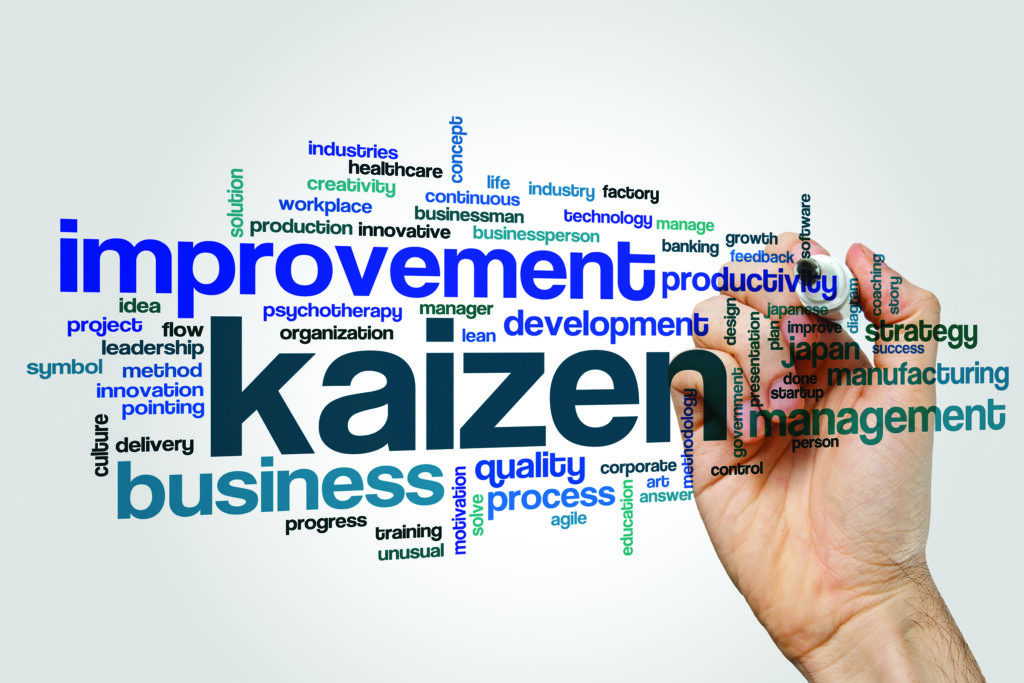This continuous improvement methodology offers great advantages. Here’s how to implement it.
The offsite construction industry, despite its tremendous potential, often grapples with inefficiencies and challenges. However, there’s a ray of hope in the form of Lean Kaizen, a methodology rooted in continuous improvement. In this article, we’ll take a comprehensive look at Lean Kaizen and show you how it can be a game-changer in your offsite factory.
Lean Kaizen is a Japanese term that roughly translates to “change for the better,” or “continuous improvement.” It’s a core component of Lean manufacturing, which is aimed at identifying and eliminating waste while improving efficiency. There are 10 basic steps you need to follow to apply Lean Kaizen in your factory:

1. Define the Problem
The first step in a Lean Kaizen effort is to clearly define the problem you want to solve. For the purposes of illustration, let’s look at an example of tool administration waste. Every offsite construction facility I’ve been in experiences some level of tool administration waste. This is where tools are handled for purposes other than adding value. These include picking up or putting down a tool; changing a bit, blade, or battery; or moving cords, hoses, ladders and jigs. These activities cause delays and reduce productivity. One factory I worked with — we’ll call them ACME Modular — was experiencing a lot of tool administration waste in their siding department.
2. Collect the Data
Once you have identified the problem, the next step is to quantify it by gathering data. The most effective way to do this is to calculate the Process Cycle Efficiency (PCE) of the process by means of video analysis. For more information on how to calculate PCE, see my article “Why Is Modular Falling Short of Its Potential?” from the February 2022 issue of Offsite Builder magazine. In the case of the ACME Modular plant, we analyzed several hours of video footage of their siding installation process. This analysis revealed that the PCE of this process was 10%, meaning that only 10% of the work time was adding value to the module. One of their biggest time wasters was tool administration waste, which accounted for a full 15.0% of the workers’ time.
3. Assemble the Team
The best way to address any problem effectively is to form a cross-functional team. Include individuals from various aspects of the production process, such as floor supervisors and logistics experts. However, it’s important that the core of the team be made up of the production workers who work in the area of focus. They are the experts in the process and will have the best ideas for improvement.
4. Identify the Root Cause
To truly get to the bottom of the issue, you will need to conduct a root cause analysis. In almost every case, the immediate cause of a problem is only the result of another cause, so we must drill down to, and then address, the root cause in order to effectively solve the problem. For a root cause analysis, we utilize techniques like Fishbone Analysis and the “5 Whys” to uncover the underlying reasons for the issue. For more information on these tools, see “Modular Process Optimization: Step 3”, from the September 2022 issue of Offsite Builder. At ACME Modular, we led the team through these exercises and determined that two major root causes of excessive tool administration waste were a) moving the pneumatic hoses around and b) worker fatigue from carrying the heavy nailer.
5. Generate Solutions
Having reached a comprehensive understanding of the problem, it’s time to brainstorm potential solutions with the team. This is where the production workers’ expertise comes into play. We had the ACME Modular siding team brainstorm solutions to these problems — first individually, then in small groups. They generated several ideas, which we then consolidated, discussed and enhanced as a team.
6. Evaluate and Prioritize
In this step, you evaluate each solution based on criteria such as potential impact, feasibility and cost-effectiveness. Use your conclusions to prioritize the solutions and to determine which you should implement first. In ACME Modular’s case, after this scoring exercise, two ideas surfaced as clear winners: purchasing a cordless pneumatic nailer and adding a lanyard to the nailer that workers could use to carry it.

7. Implement the Changes
Now you need to put the chosen solution, or solutions, into action. In ACME Modular’s case the main solution was a simple one: the purchase of new tools. Once the tools arrived, ACME’s team immediately put them to use in their work. I’ve seen other cases where workstations needed to be rearranged to facilitate quicker tool access. Whatever the solution, make sure that all team members are informed about, and aligned with, the new approach.
8. Follow-Up and Monitor
Continuously monitor the situation to ensure that the problem is resolved. On the factory floor, this means tracking time spent administering tools, and most importantly, the quantity of work produced per labor hour. When I followed up with ACME Modular’s siding team several weeks into implementation, they excitedly reported that, whereas siding an average module used to take them three days to complete, with the new tools (and some other changes to the process), they were now able to complete a module in one day. That’s a 300% improvement in labor productivity!
9. Standardize and Document
Once a successful solution is achieved, make it the new standard procedure. Document it comprehensively and provide training to ensure consistent implementation across shifts and teams. For instance, once we had confirmed the improvement at ACME Modular, the next step was to update the Standard Work Instructions (SWI) to reflect the new best practices.
10. Celebrate and Share
Acknowledge the efforts of the team and celebrate the improvements. Share the results and lessons learned with the broader organization. This not only recognizes the dedication of the team, but also encourages others to embrace Lean Kaizen principles in their work. Every time you make an improvement through Lean Kaizen, you want your entire team to implement the improvement, to maximize its benefits to the organization. Conclusion Lean Kaizen offers a potent strategy for addressing all types of process issues on the factory floor in offsite construction. By meticulously identifying problems, collecting and analyzing data, involving a diverse team, generating solutions and implementing improvements, Lean Kaizen empowers your offsite construction company to operate more efficiently, reduce waste and unlock its full potential.
Daniel Small is a Denver, Colo.-based management consultant to the offsite construction industry. He specializes in Lean Construction and Manufacturing and Six Sigma methodologies. For assistance with improving your offsite manufacturing process, contact him at 719-321-1953 or [email protected]. Or visit www.LeanOffsite.com.

















